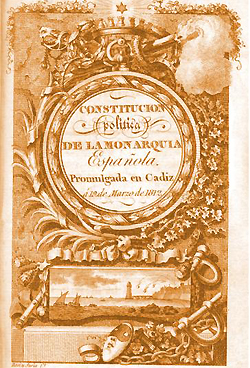 |
| La Pepa 1812 - 2012 |
On 19 March 1812, Spain’s first constitution was drawn up in Cadiz, enshrining the rights of Spanish citizens and limiting the power of the monarchy. Although it was not enacted for some years, its influence was considerable, both within peninsular Spain and its territories around the world.
What’s its background?
September 1810: It is almost five years after the Battle of Trafalgar, at which the English defeated the Spanish fleet, then allied to the French. Napoleon’s troops are now occupying France, the Peninsular Wars (known as the Guerra de Independencia) are raging, and the English and Portuguese are helping to drive the French out of Spain. The Spanish King is Napoleon’s brother Joseph, placed on the throne by the French Emperor in 1808, replacing the legitimate monarch Carlos IV.
The Cortes Generales (General Courts), Spain’s national legislative assembly, has taken refuge from the French in the city of Cadiz. A group of liberals, who refused to support the king imposed on them by the French occupiers, forms the majority of the deputies (members of parliament), while the Church, landowners and aristocracy are in the minority.
March 1812: Napoleon’s troops are besieging Cadiz. The Gaditanos fear that they can’t hold out much longer.
In a vehement desire to protect the fundamental rights of the Spanish people, the 300-odd deputies devote themselves to drawing up a liberal constitution proclaiming a democratic parliamentary monarchy.
What does it say?
The constitution, promulgated (formally proclaimed) on 19 March 1812, has three initial main points: to confirm the legitimacy of the monarch; to enshrine the inviolability of the deputies; and to establish national sovereignty. It’s a clear statement to Napoleon: this is still Spain, and we are still Spanish. But the constitution also says to the succession of corrupt monarchs who have been in power: enough! We want to rule ourselves now.
As well as being designed to limit the absolute power of the monarch and outlawing corruption, it reduces the Church and nobility’s influence; and it protects the rights of the citizens, threatened by a foreign occupier. It makes all men equal, giving them the right to vote; protects the freedom of the press; and supports reform of tax and land law (the removal of the feudal system). The constitution also states that one ayuntamiento must be created for every 1,000 people, in all Spanish lands.
In addition, voting rights are afforded to all those with ancestry in Spain or the Spanish Empire. Of the deputies present, over 10 per cent (37 out of 303) were born in overseas territories, including Peru, Cuba, Venezuela, Puerto Rico and the Phillippines. Deputies present from lands which later become Ecuador, Mexico, Chile and Peru all go on to be key figures in founding their own republics.
The exact date when this historic document was published (the equivalent of being included in today’s BOJA), 19 March, is Dia de San Jose; for this reason, the constitution becomes known as La Pepa.
 |
| The First Spanish Constitution |
The legacy of La Pepa
As revolutionary as the new constitution was – it curtailed the monarch’s power, affording ordinary people rights they had never had, and was commemorated in many Spanish towns and cities with an “Avenida de la Constitution” or “Plaza de la Constitution” - French occupation meant that it wasn’t enacted for some years. Nor was its fate much happier later on.
When the monarchy was restored soon after, in 1814, one of the first acts of King Fernando VII de Borbon (son of Carlos IV) was to revoke the constitution. After this, its fortunes remained mixed: mostly unrecognised, it was reinstated from 1820-1823 and 1836-1837.
However despite its lack of immediate influence, La Pepa was an important document in the history of liberalism in Spain. It was also used as a model for liberal constitutions in Portugal and New World territories, who gained their independence from the Spanish crown in the early 19th century.
Spain has had seven constitutions since La Pepa; the current one was enacted in 1978, in the Transition years after Franco’s death.